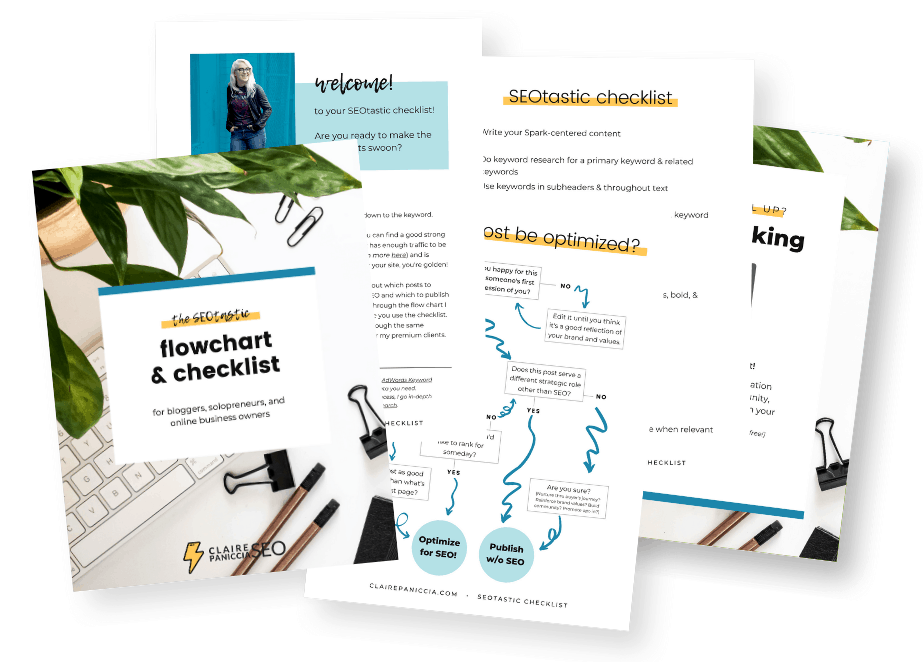
I’m gonna go out on a limb and guess that the extent of your knowledge about keyword density is this: You pick a keyword, plug it into Yoast, and it tells you your keyword density isn’t high enough. It suggests you add it a few more times, so you do.
But are you actually seeing any growth from that?
Probably not. (Especially if you’re not doing your keyword research before you do any of this).
So what does this mean for you, my fine blogging friend?
It means that a lot of the SEO strategies that used to work, and a lot of the content you wrote way back when, won’t be working as hard for you anymore.
Because when those posts were published, keyword density was critical.
Now it’s not.
In this post, I’m going to show you exactly what keyword density is, how it used to fit into the Google algorithm, why it’s completely irrelevant for 2019 SEO, and what you should focus on instead.
What is Keyword Density?
Keyword density is a percentage that indicates how often your targeted keyword (aka your focus keyword, and the term you want to appear in search results for) appears in your content, relative to how long your content is in total.
[wc_box color=”primary” text_align=”left”]
Keyword Density Formula:
Keyword Density = (#x targeted keyword appears) / (total word count for content) * 100
[/wc_box]
It’s a pretty simple concept, but there are lots of myths masquerading around as SEO advice that say you need to have a certain keyword density to rank well.
All things considered, for search engine optimization as it currently stands, this is utter bologna.
Now, these SEO advice-givers aren’t completely full of sh*t. Keyword density used to be critical.
The Origins of Keyword Density
Back in the early days of Google, the algorithm used to analyze web pages based on how many times the search term appeared. So from a searcher’s perspective, they typed in a search term, and the results on the first page were the ones that showed that exact term the most times.
This is basically Stone Age SEO.
So marketers and webmasters started creating content specifically to rank on the first page for terms they wanted to be seen for.
This is still something we do today, but the way we do it looks completely different now.
Back then, the content they created to rank in Google was complete crap. They stuffed the exact match keyword onto the page as many times as they could.
[wc_box color=”primary” text_align=”left”]
What is keyword stuffing?
Keyword stuffing is when you use your target keyword so often in your content that it feels unnatural, in an attempt to “hack” the algorithm.
(In modern SEO, this actually hurts rather than helps your rankings.)
[/wc_box]
This led to a crappy user experience for Google searchers.
Think about it. If you google’d “burrito recipe”, back then you’d get a whole bunch of pages stuffed with the term “burrito recipe” every third word. Doesn’t sound like a very useful recipe, does it?
So Google got smarter.
And smarter. And smarter and smarter and smarter.
Because that’s the whole raison d’etre of Google search, right? To give Google searchers the best possible user experience.
So every algorithm update is designed to get the Google experience closer and closer to that goal.
This all means that nowadays, keyword stuffing doesn’t work. Not only does it not work, it will get your page punished!
Now, most of the time, when you see a resource talking about keyword density as a good thing, they don’t actually mean you should stuff your page. They’re suggesting keyword density around 1-3%. Hardly stuffing.
But the real question is this: does the specific keyword density percentage actually impact where your content ranks in Google? Does it actually help you get on the first page?
The answer?
No.
There is no significant data that shows a specific percentage of keyword density having a direct impact on ranking anymore.
So in my opinion, there’s no point in stressing out about keyword density, making sure your posts all hit exactly 2.7% keyword density. *eyeroll*
The Google algorithm has gotten infinitely more sophisticated than it’s simplistic origins.
Google Algorithm Updates that Impact Keyword Density
Every once in a while, the internet buzzes with the latest “Google algorithm update” and how it’s tanking everyone’s site and the internet is on fire.
Obviously, most of the time that’s just hype/panic and you’re probably fine.
Google actually makes changes to the algorithm multiple times a day! They’re just usually tiny ones that are pretty imperceptible.
(If you’re a huge SEO geek like me, you can actually watch for these tiny fluctuations in ranking that indicate some kind of algo updates on MozCast, a free tool that reports those fluctuations as if it was weather. The higher temperature, the bigger the fluctuations. Cool, right?)
Every once in a while, though, Google make a big giant update to their top secret algorithm that really sends some sites into a tailspin. And even less frequently, there’s an update that completely changes the face of SEO as we know it.
The latter type is super rare, but also the most important to be aware of, so we’re going to focus on those types of updates that have had an impact on the importance of keyword density.
One of the major algorithm updates that impacted the importance of keyword density was Hummingbird. Let’s dig in.

Hummingbird
If you’ve ever heard a blogging blogger say “insert your keyword a few times in your post”, they need to learn about Hummingbird.
While they’re not technically wrong, they’re also not giving you an actual technique to succeeding at SEO.
Why do I say this so bluntly?
When Google introduced the Hummingbird update in 2013, they pretty much completely demolished exact-match keyword optimization. Basically, just including your exact target keyword a few times in your post doesn’t cut it anymore, thanks to Hummingbird.
This is actually a good thing. It makes the internet better. Let me explain.
Hummingbird is all about Google understanding what a search term actually means, rather than just looking for the page that includes the exact phrase the most times.
It understands “things, not strings”
Remember in the early 2000s, when you had to do a Google search a few times, trying out different variations on your search term before you found what you were looking for?
How often do you need to do that nowadays? Not nearly as often.
In large part, that’s because of the Hummingbird update.
[wc_box color=”primary” text_align=”left”]
How many keywords should I use?
If you're still wondering how many keywords per page you should use, you're still focusing on the wrong things.
Once you've got your target keyword picked out, shift your focus.
Don't focus on the keyword while you're writing the content. Instead, focus on the topic.
[/wc_box]
What to Focus on Instead
So now you know that focusing on keyword density and worrying about the proportion of times your targeted keyword is mentioned in your post is a total waste of energy.
But if “inserting your keyword a few times” doesn’t cut it for results anymore, how do you get results?
There’s a few other things you should be putting your energy into instead. Ones that actually will bring you results. Let’s talk about those
Write Super In-Depth Content on Your Target Topic
If you want a post that targets traffic from a keyword about certain topic, the number one way to get those rankings people actually see in search results is to write the best damn post on the topic.
Because of Hummingbird (and the more recent RankBrain), Google can understand what a term actually means. It can do this, in large part, by extrapolating context from other content on the page.
For example: If you’re writing about house-training your dog, Google will probably expect to see a breakdown of different methods or philosophies, mentions of clickers, crates, treats, and praise, how different breeds respond to it, and maybe an explanation of the difference between training a puppy versus an adult rescue.
If you’re thinking, “But Claire, I don’t want to write the next Great American Novel about dog training! I just wanted to write a cute, quick blog post about puppies peeing in your kitchen and move on!”, well, that's great and all, but it won't bring you any traffic.
Think from the searcher’s perspective. If they’re looking for articles about house training their dog, is a cute article going to actually help them? Or will they click the back button and keep sifting through other results on Google?
They’ll click the back button, of course!
Always keep the keyword intent in mind.
If it’s not fully answering the searcher’s need, it’s not going to rank highly for your keyword. No one will find it, no one will click through it, no one will purchase product from it.
If no one’s going to find that post, there’s no point in writing it.
Better to spend the effort now in creating something that will bring you results for the long-haul (think on a scale of months! Years! Eons! Well, maybe not eons… but hey, you never know!).
The modern internet has become a cluttered place. To succeed requires quality.
Look What’s On the First Page, and Do Better
This is really just a different way to approach the “super in-depth content” idea above, but I’ve had so much success with it I think it’s worth exploring independently.
This technique, commonly called the “Skyscraper Method” based on the case studies by Brian Dean of Backlinko, involves researching what the first page results are publishing for your target keyword.
This is exactly what I did in this SEO case study when I revamped and re-published the virtual mailbox post for one of my travel blogger clients.
I looked to see what similar types of pages were publishing to get on the first page, and attempted to match or out-do them.
Now that post gets 450% more traffic per day and is consistently one of my client’s top 5 traffic-driving pages (and monetized to boot).

Include Related Subtopics and Keywords, not just the main topic
Because Google’s trying to help users answer their question without having to hop pages a million times, super in-depth content is favored. This means that Google likes to see pages that cover any and all follow up questions a person may have on the subject.
For example: if someone is searching “intermittent fasting”, they’re probably curious and looking for more info to decide if they want to try it.
So the results on the first page of Google for the search term “intermittent fasting” all cover lots of subtopics that that person would have as they continued to learn more.
For example, almost all of them spend some paragraphs explaining “what it is” before talking about the different common methods or schedules you can use. They also all list different benefits and also reference the different effects on men and women or whether women should try it.
Other articles about intermittent fasting that are shorter, less in depth, or missing these subtopics, probably won’t be able to compete with this super in-depth article from NerdFitness.
Conquering the SERPs is totally possible
It’s totally possible to get your posts high in Google results and bring traffic to your site. But in 2019 it takes more work than “sprinkling your keyword” throughout your posts.
While you do want to make sure you’re not making your target keyword every third word in your content (aka keyword stuffing), calculating the exact percentage of keyword density is not going to help your post rank higher and bring in more search traffic.
Instead, focus on writing the most in-depth piece of content around on that particular topic, blow your SERP competition out of the water, and include subtopics and related keywords.
If this sounds like a lot of work, well, it is. (Sorry). But thankfully, creating SEOtastic content isn’t something you need to master on your own; you can work with me instead.
By working with an SEO pro like me, you can succeed and conquer at SEO while focusing on the work you enjoy and are awesome at.
Schedule your free discovery call to learn more about SEO and how it will help your business grow.
Free SEOtastic Flowchart & Checklist

